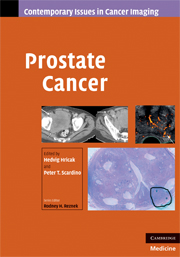Book contents
- Frontmatter
- Contents
- Contributors
- Series Foreword
- Preface
- 1 Anatomy of the prostate gland and surgical pathology of prostate cancer
- 2 The natural and treated history of prostate cancer
- 3 Current clinical issues in prostate cancer that can be addressed by imaging
- 4 Surgical treatment of prostate cancer
- 5 Radiation therapy
- 6 Systemic therapy
- 7 Transrectal ultrasound imaging of the prostate
- 8 Computed tomography imaging in patients with prostate cancer
- 9 Magnetic resonance imaging of prostate cancer
- 10 Magnetic resonance spectroscopic imaging and other emerging magnetic resonance techniques in prostate cancer
- 11 Nuclear medicine: diagnostic evaluation of metastatic disease
- 12 Imaging recurrent prostate cancer
- Index
- Plate section
- References
2 - The natural and treated history of prostate cancer
Published online by Cambridge University Press: 23 December 2009
- Frontmatter
- Contents
- Contributors
- Series Foreword
- Preface
- 1 Anatomy of the prostate gland and surgical pathology of prostate cancer
- 2 The natural and treated history of prostate cancer
- 3 Current clinical issues in prostate cancer that can be addressed by imaging
- 4 Surgical treatment of prostate cancer
- 5 Radiation therapy
- 6 Systemic therapy
- 7 Transrectal ultrasound imaging of the prostate
- 8 Computed tomography imaging in patients with prostate cancer
- 9 Magnetic resonance imaging of prostate cancer
- 10 Magnetic resonance spectroscopic imaging and other emerging magnetic resonance techniques in prostate cancer
- 11 Nuclear medicine: diagnostic evaluation of metastatic disease
- 12 Imaging recurrent prostate cancer
- Index
- Plate section
- References
Summary
Introduction
Adenocarcinoma of the prostate is the most common visceral cancer of industrialized nations and the second most lethal cancer among men. In the United States alone, 186 000 new cases are expected and over 28 000 men will die from this disease in 2008 [1]. Therefore, while prostate cancer is a leading cause of cancer death, the vast majority of men survive the disease and ultimately die of other causes. Currently it is estimated that a man's lifetime risk of being diagnosed with prostate cancer is 1 in 6. These odds are expected to increase as the combination of improved medical therapy and lifestyle modifications lead to prolonged population longevity. It is well known that not all prostate cancer patients will benefit from interventions with curative intent as many tumors will remain indolent throughout the patient's life. In fact it is estimated that only 3% of all men, or about 1 in 6 of all prostate cancer patients, will die of this disease. Nevertheless, a significant proportion of prostate cancer patients who die of other causes may well suffer from disease progression or treatment complications during their lifetime. Thus, the clinical sequelae of prostate cancer can be quite variable, ranging from the tumor being discovered incidentally without any symptoms, to patients presenting with widely metastatic, treatment-resistant disease that is rapidly fatal. Thus prostate cancer often presents perplexing management questions to clinicians who treat this disease.
- Type
- Chapter
- Information
- Prostate Cancer , pp. 15 - 28Publisher: Cambridge University PressPrint publication year: 2008
References
- 2
- Cited by



